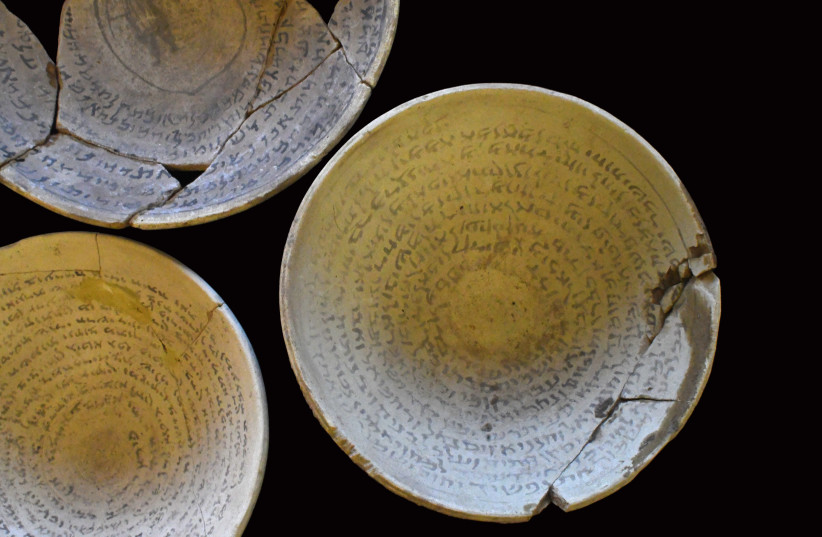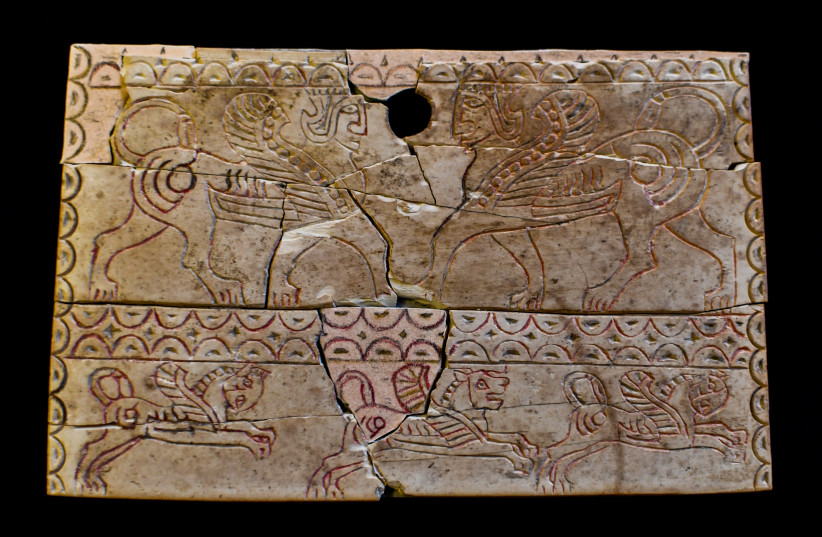The Antiquities Authority (IAA) has uncovered 1,500-year-old magical “incantation bowls” and other rare and decorated bone and ivory items dating from the biblical period in the home of a Jerusalem resident suspected of participating in the illegal antiquities trade.
Hundreds of antique bronze and silver coins, glassware and ancient weapons were also discovered in the Ramat Shlomo neighborhood home during a search by the IAA’s Robbery Prevention Unit and the Israel Police, the IAA said in a press release.
The bowls, which are inscribed with spells and incantations in Hebrew, date back to the eighth-fourth centuries CE and were used as a type of amulet in ancient times. They are also known as “swearing bowls,” the IAA said.
The inscriptions were meant to fight curses, demons, diseases and pests, and the bowls were commonly buried under a family’s house floor for protection.
Various chemicals that were confiscated from the house are believed to have been intended for use in the restoration of the pottery and for cleaning ancient metals and coins. The IAA believes the suspect repaired and restored the bowls to sell them.

Following an investigation of the suspect, the IAA inspectors went to an auction house in the center of the country, where they seized additional ancient artifacts that had been put up for sale illegally by the suspect.
These types of incantation bowls come from ancient sites in present-day Iraq, where Mesopotamia was once located, said Amir Ganor, head of the IAA’s Robbery Prevention Unit. Following the war in Iraq in 2003, thousands of stolen incantation bowls began to enter the international trade markets, he said.
“The text was written by artists for a specific client, according to their personal needs,” Ganor said. “Occasionally, as can be seen in one of the bowls, a figure of the ‘night demon’ was painted in the center of the bowl, representing the individual that the bowl was meant to ward off.”

The seized items also include rare bone and ivory objects decorated in Phoenician style, with Egyptian motifs that included scenes from the animal world, alongside geometric ornaments from the biblical period.
Two griffons (winged lions with human faces) facing each other appear in one of the objects, and another artifact included a description of a convoy of four-winged lions marching one after the other, the IAA said.
Similar ivory objects have been discovered in past excavations in an antiquity site in Samaria, where a large collection of ivory, known as “Samaria Ivories,” was discovered, as well as at other antiquity sites, such as Tel Megiddo, the IAA said.
The items were used as decorations, attached to wooden furniture by nails in the ninth and eighth centuries BCE.
The IAA said finding decorated artifacts made of ivory from this period is extremely rare. The Robbery Prevention Unit believes they were excavated illegally in one of the biblical mounds in Samaria or in the North.
Documents seized from the suspect’s home may shed light about his connections with antiquities robbers and unauthorized dealers, the IAA said.
“Unauthorized antiquities dealers encourage looters to go out and destroy ancient sites in search of finds for sale on the antiquities market,” IAA Director-General Eli Eskosido said. “In the name of greed, they plunder antiquity sites, removing the finds from their historical context, thus obscuring parts of human history.”
At the end of the investigation, the case file will be transferred to the Antiquities Authority’s Legal Bureau to examine the filing of an indictment for attempted trade in antiquities without a permit, failure to report the discovery of an antique, failure to register a collection and possession of property suspected of being stolen, which are all criminal offenses for which the statutory penalty is up to three years in prison, the IAA said.
